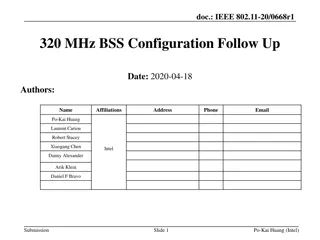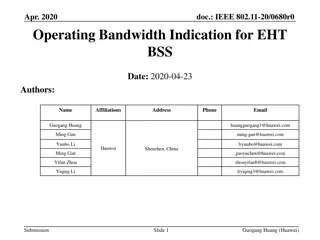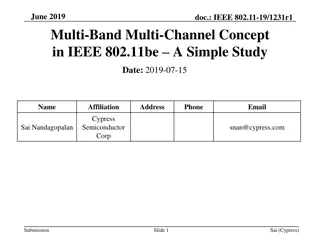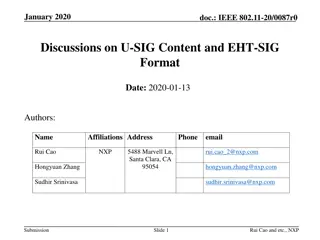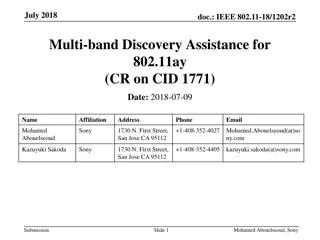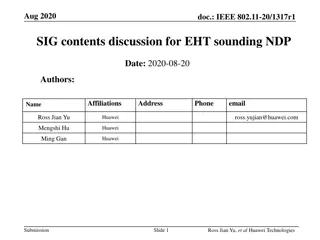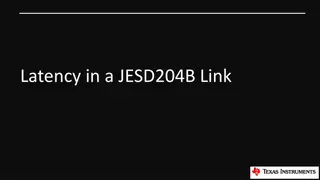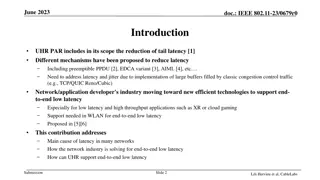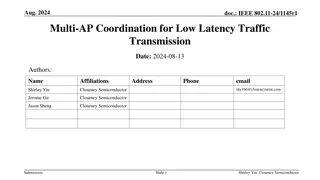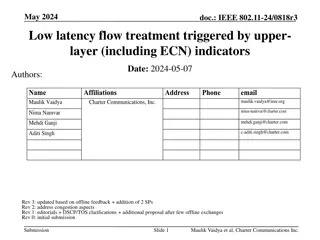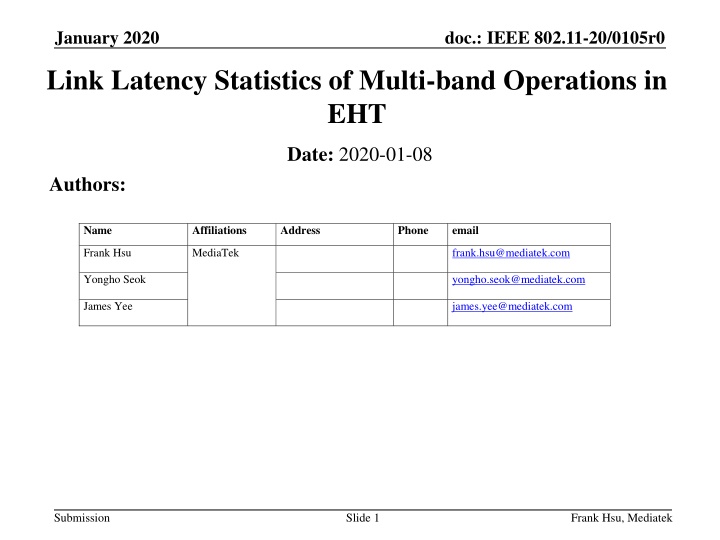
Improving Latency Statistics for EHT Multi-band Operations
Explore how latency statistics play a crucial role in enhancing multi-band operations within EHT technology. This study delves into various latency-related elements and proposes adding more statistics to optimize connection stability and throughput in IEEE 802.11 networks.
Download Presentation

Please find below an Image/Link to download the presentation.
The content on the website is provided AS IS for your information and personal use only. It may not be sold, licensed, or shared on other websites without obtaining consent from the author. If you encounter any issues during the download, it is possible that the publisher has removed the file from their server.
You are allowed to download the files provided on this website for personal or commercial use, subject to the condition that they are used lawfully. All files are the property of their respective owners.
The content on the website is provided AS IS for your information and personal use only. It may not be sold, licensed, or shared on other websites without obtaining consent from the author.
E N D
Presentation Transcript
January 2020 doc.: IEEE 802.11-20/0105r0 Link Latency Statistics of Multi-band Operations in EHT Date: 2020-01-08 Authors: Name Affiliations Address Phone email Frank Hsu MediaTek frank.hsu@mediatek.com yongho.seok@mediatek.com james.yee@mediatek.com Yongho Seok James Yee Submission Slide 1 Frank Hsu, Mediatek
January 2020 doc.: IEEE 802.11-20/0105r0 Introduction In EHT, latency improvement is the key task Multilink operation(MLO) targets to increase the overall throughput and to improve connection stability. For EHT MLO, in the view of load balance In addition to legacy BSS load statistics, latency serves as another important indicator helping STA to understand if a link is qualified for time critical applications AP can further provide latency statistics of each link to help STA using a suitable link This contribution explores latency statistics in current specs. and proposes to add more latency statistics in EHT for MLO Submission Slide 2 Frank Hsu, Mediatek Inc.
January 2020 doc.: IEEE 802.11-20/0105r0 Re-cap of Latency Related Elements [1] BSS Average Access Delay element contains the AP Average Access Delay, which is a measure of load in the BSS and is available in both QoS APs and non-QoS APs. BSS AC Access Delay element contains an Access Category Access Delay. Use same delay definition as the BSS Average Access Delay but separate measures of each access category Measurement Report element In Transmit Stream/Category Measurement report, average queue delay and average transmit delay are reported for a TS or TC to a specific peer STA Submission Slide 3 Frank Hsu, Mediatek Inc.
January 2020 doc.: IEEE 802.11-20/0105r0 Delay Types Queue delay Channel(Medium) access delay Transmit delay Submission Slide 4 Frank Hsu, Mediatek Inc.
January 2020 doc.: IEEE 802.11-20/0105r0 Queue Delay MSDU base Queue delay is measured from the time the MSDU is passed to the MAC until the point at which the first or only corresponding MPDU begins transmission. (TS/TC Measurement report) Each access category has its own queue. Average queue delay of access categories is different EDCA in 802.11, four ACs are defined VO, VI, BK, and BE MSDU Access Category Mapping Enter the queue BE BK VI VO EDCA Ctrl EDCA Ctrl EDCA Ctrl EDCA Ctrl In the EDCA control to WM To Wireless Medium Submission Slide 5 Frank Hsu, Mediatek Inc.
January 2020 doc.: IEEE 802.11-20/0105r0 Channel Access Delay MPDU base Channel(Medium) access delay is measured from the time the DCF or EDCAF MPDU is ready for transmission (i.e., begins CSMA/CA access) until the actual frame transmission start time. (BSS Average Access Delay element) No considerations of collision or failed transmission PPDU carries the MPDU in transmission EDCA counter count down The instant the MPDU is ready for transmission in EDCA/DCF ctrl Submission Slide 6 Frank Hsu, Mediatek Inc.
January 2020 doc.: IEEE 802.11-20/0105r0 Transmit Delay (1/2) MSDU base Transmit delay is measured from the time the MSDU is passed to the MAC until the point at which the entire MSDU has been successfully transmitted, including receipt of the final Ack frame from the peer STA if the QoS Ack service class is being used. (TS/TC Measurement report) Submission Slide 7 Frank Hsu, Mediatek Inc.
January 2020 doc.: IEEE 802.11-20/0105r0 Transmit Delay (2/2) Collision or retransmission may happen Transmit delay counts until the MSDU is successfully Acked by the peer STA If an MSDU is divided into fragments, delay counts until all fragments are Acked If an MSDU is discarded due to timeout or other reasons, the MSDU is not taken account into transmit delay measurement Transmit delay is not equal to queue delay + channel access delay Collision Retransmission PPDU carries the MSDU PPDU carries the MSDU ACK Channel access timer ends The instant confirms the transmit delay timer end Submission Slide 8 Frank Hsu, Mediatek Inc.
January 2020 doc.: IEEE 802.11-20/0105r0 Current Latency Statistics Insufficiency BSS Average/BSS AC Access Delay elements cover only channel access delay. Channel access delay is not accurate enough information without considering transmission failure Transmit delay and queue delay are by request and only cover delay statistics between two peer STAs Transmit delay conveys key information how long it takes for an MSDU being successfully delivered to the destination but there is no such information measured in BSS or in link base Average based statistics are not enough for latency critical applications [2] Submission Slide 9 Frank Hsu, Mediatek Inc.
January 2020 doc.: IEEE 802.11-20/0105r0 Latency Statistics in EHT MLO In the view of load balance, especially for latency critical applications, average and percentile statistics of transmit delay on each link are necessary EHT STAs running time critical applications may set transmit delay statistics as a higher priority reference for traffic distribution Transmit delay can be separately generated depending on MSDU sizes, such as small, medium, and large MSDUs for specific traffic types Submission Slide 10 Frank Hsu, Mediatek Inc.
January 2020 doc.: IEEE 802.11-20/0105r0 Usage Examples Load balance: AP can steer delay sensitive STAs to a link with shorter latency Single link devices may pick up a low latency link during association. TID mapping assistance: For a TID mapping to multiple links, sending MSDUs to a link already suffering from long latency may further increase traffic congestion Link 1 Link 2 AP STA Submission Slide 11 Frank Hsu, Mediatek Inc.
January 2020 doc.: IEEE 802.11-20/0105r0 Latency Statistics Proposal for EHT MLO EHT MLO AP should provide latency statistics of each link, including Average transmit delay over all ACs 95% percentile transmit delay over all ACs Average transmit delay of the highest priority AC 95% percentile transmit delay of the highest priority AC Average MSDU loss rate In optional subelements, Detailed transmit delay statistics depending on MSDU sizes Detailed delay statistics such as queue delay and channel access delay Detailed delay statistics of each AC Enhancement in measurement report element to cover UL transmit delay of STA, such percentile statistics Submission Slide 12 Frank Hsu, Mediatek Inc.
January 2020 doc.: IEEE 802.11-20/0105r0 Straw Poll 1 Do you support that EHT MLO AP should provide transmit delay statistics of each link carried in an information element? Submission Slide 13 Frank Hsu, Mediatek Inc.
January 2020 doc.: IEEE 802.11-20/0105r0 Straw Poll 2 Do you support the delay statistics proposed in slide 10 for EHT AP? Submission Slide 14 Frank Hsu, Mediatek Inc.
January 2020 doc.: IEEE 802.11-20/0105r0 References 1. IEEE 802.11md D3.0 2. 11-18-1160 Controlling latency in 802.11 Submission Slide 15 Frank Hsu, Mediatek Inc.


